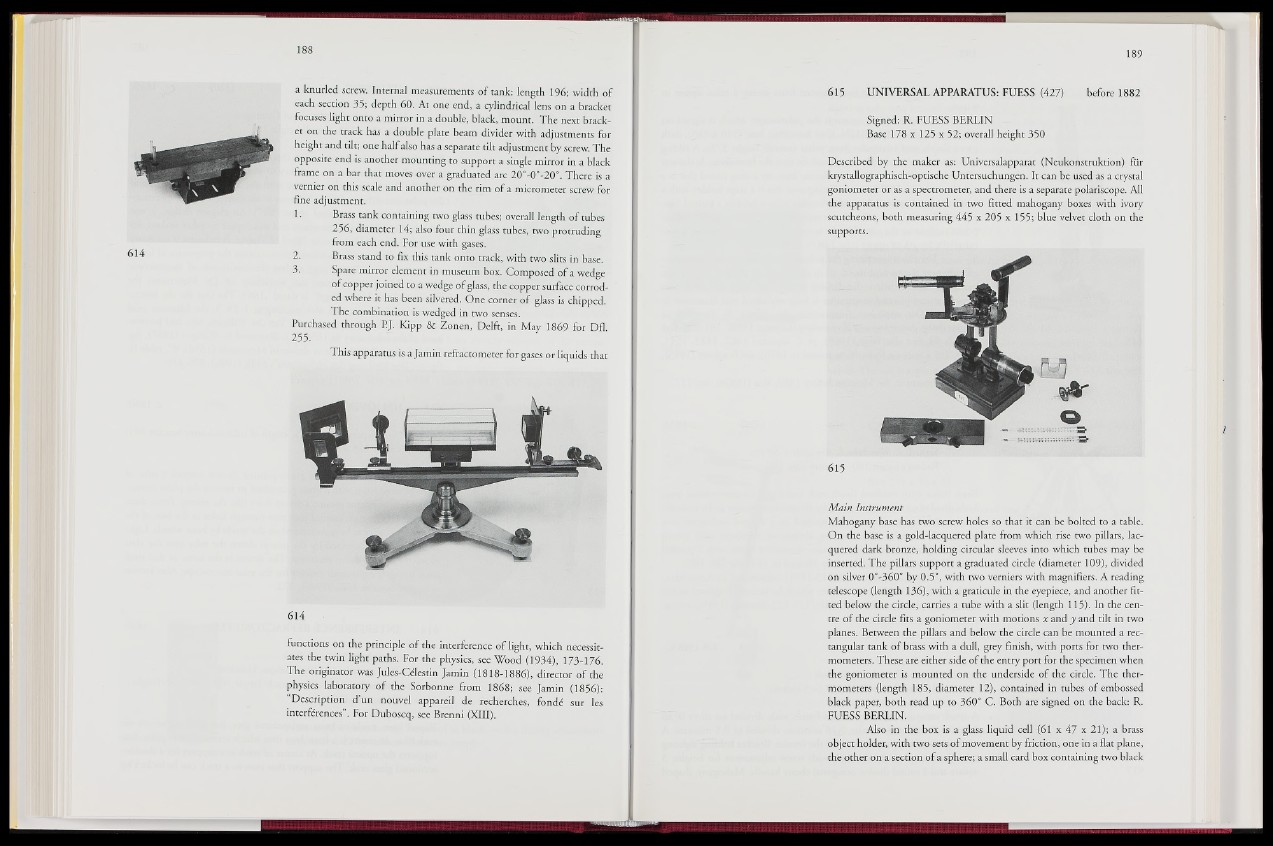
614
a knurled screw. Internal measurements of tank: length 196; width of
each section 35; depth 60. At one end, a cylindrical lens on a bracket
focuses light onto a mirror in a double, black, mount. The next bracket
on the track has a double plate beam divider with adjustments for
height and tilt; one half also has a separate tilt adjustment by screw. The
opposite end is another mounting to support a single mirror in a black
frame on a bar that moves over a graduated arc 20°-0°-20°. There is a
vernier on this scale and another on the rim of a micrometer screw for
fine adjustment.
1. Brass tank containing two glass tubes; overall length of tubes
256, diameter 14; also four thin glass tubes, two protruding
from each end. For use with gases.
2. Brass stand to fix this tank onto track, with two slits in base.
3. Spare mirror element in museum box. Composed of a wedge
of copper joined to a wedge of glass, the copper surface corroded
where it has been silvered. One corner of glass is chipped.
The combination is wedged in two senses.
Purchased through P.J. Kipp & Zonen, Delft, in May 1869 jfor Dfl
255.
This apparatus is a Jamin refractometer for gases or liquids that
614
functions on the principle of the interference of light, which necessitates
the twin light paths. For the physics, see Wood (1934), Tf'3-176.
The originator was Jules-Célestin Jamin (1818-1886), director of the
physics laboratory o f the Sorbonne from 1868; see Jamin (1856);:
Description d’un nouvel appareil de recherches, fondé sur les
interférences”. For Duboscq, see Brenni (XIII).
615 UNIVERSAL APPARATUS: FUESS (427} before 1882
Signed: R. FUESS BERLINS)-
Basei]>78 x 125 x 52; overall height 350
Described by the maker as: Universalapparat (Neukonstruktion) fur
krystallographisch-optische Untersuchungen. It can be used as a crystal
goniometer or as a spectrometer, and there is a separate polariscope. All
the apparatus is contained in two fitted mahogany boxes with ivory
scutcheons, both measuring 445 x 205 x 155; blue velvet cloth on the
supports.
615
Main Instrument
Mahogany base has two screw holes so that it can be bolted to a table.
On the base is a gold-lacquered plate from which rise two pillars, lacquered
dark bronze, holding circular sleeves into which tubes may be
inserted. The pillars support a graduated circle (diameter 109), divided
on silver 0°-360° by 0.5°, with two verniers with magnifiers. A reading
telescope (length 136), with a graticule in the eyepiece, and another fitted
below the circle, carries a tube with a slit (length 115). In the centre
of the circle fits a goniometer with motions x and y and tilt in two
planes. Between the pillars and below the circle cant be mounted a rectangular
tank of brass with a dull, grey finish, with ports for two thermometers.
These, are either sidjiof the entry port for the specimen when
the goniometer is mounted on the underside of the circle. The thermometers
(length 185, diameter 12), contained in tubes of embossed
black paper, both read up to 360° C. Both are signed on the back: R.
FUESS BERLIN.
. Also in the box is a glass liquid qejT?(61 x 47 x S H a brass
object holder, with two sets of movement by friction, one in a flat plane,
the other on a section of a sphere; a small card box containing two black